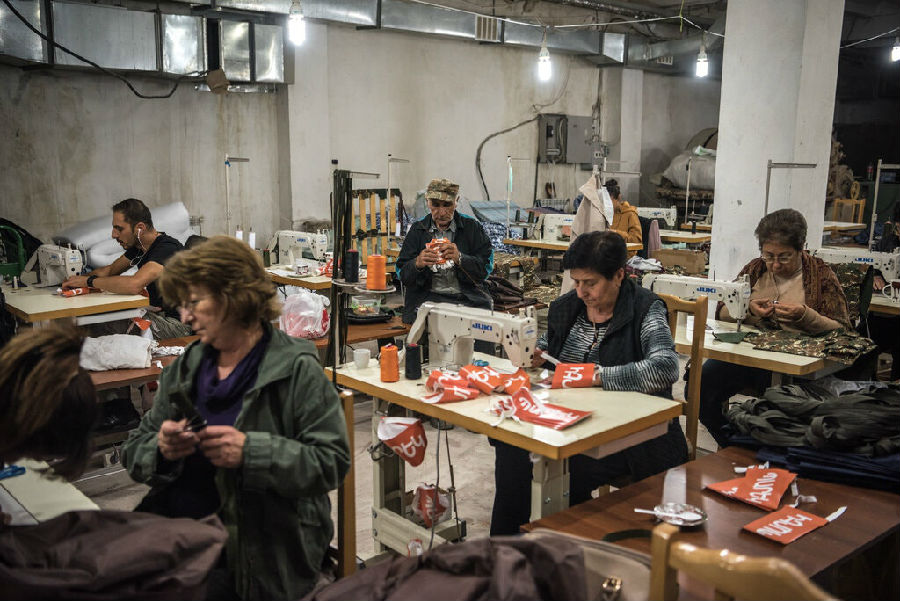On Saturday, Armenia and Azerbaijan announced they had negotiated a truce, mediated by France,
周六,亞美尼亞、阿塞拜疆宣布,他們在法國的斡旋下,通過談判達成了休戰協議,
to allow bodies to be collected and prisoners to be exchanged.
允許彼此收尸并交換囚犯。
But as with a Russian-brokered cease-fire reached a week earlier, the fighting has continued,
然而,與一周前在俄羅斯斡旋下達成的停火協議一樣,談判結束后,雙方并未停止交戰,
with each side accusing the other on Sunday of violating the truce.
還互相指責對方違反了停火協議。
"Their war effort against the Armenians is principally an attrition fight,"
“他們針對亞美尼亞人發動的戰爭其實是一場消耗戰,”
Michael Kofman, a military analyst at CNA, a nonprofit research and analysis organization in Arlington, Va., said of Azerbaijan's campaign.
位于弗吉尼亞州阿靈頓的非營利性研究分析機構CNA的軍事分析師邁克爾·科夫曼在談到阿塞拜疆的行動時說道。
"It's not really well organized with a clear theory of victory."
“他們的行動并沒有很好的組織性,也沒有清晰的取勝方針。”
Outgunned, Armenia has thrown conscripts and volunteers into the battle.
受到火力壓制的亞美尼亞已經開始將征召入伍的平民和志愿者送上戰場。
Some of the latter are veterans of the 1990s war, like Artur Aleksanyan,
部分志愿者還是阿圖爾·阿列克桑揚那樣從90年代那場戰爭的前線下來的退伍軍人,
a retired special forces colonel who said he was in the hospital recovering from surgery when the current conflict began.
曾任特種部隊上校的阿列克桑揚說,此次沖突爆發時,他正在醫院等待術后康復。
He said he now leads a volunteer unit in the trenches to the north, battling to halt the Azerbaijani advance.
據他透露,如今他正帶領一支志愿部隊在北部的戰壕作戰,努力阻止阿塞拜疆的推進。
It has been 15 years since he last wielded a weapon, Mr. Aleksanyan said Saturday in an interview in Stepanakert,
上次拿起武器已經是15年前的事了,阿列克桑揚周六在斯捷潘納克特接受采訪時說道,
where he was picking up a bag full of radio equipment before driving back to the front.
接受采訪時,他正在搬一個裝滿無線電設備的袋子,準備開車回前線。

He lifted his uniform to show the bandages around his belly which he has to change eight times a day
他掀起制服,露出了肚子上的繃帶,那是他每天都要更換八次的繃帶,
and rapped his knuckles against his artificial kneecap, a reminder of his last war.
接著,他又用手指敲了敲他的假膝蓋,那也是上一次戰爭留下的印記。
But this conflict is nothing like the 1990s, Mr. Aleksanyan said.
不過,阿列克桑揚表示,此次沖突不同于20世紀90年代的那場沖突。
Then, the Kalashnikov rifle was the principal weapon.
90年代那場沖突使用的主要武器是卡拉什尼科夫步槍。
This time, there are few exchanges of small-arms fire.
而這一次,雙方幾乎沒有用到任何輕武器。
Of his unit's 17 days at the front, he said, 15 days were spent in the trenches,
他還說,他領導的志愿者部隊守在前線的17天中,有15天都是在戰壕中度過的,
taking cover from artillery barrages that came as frequently as every 20 minutes.
以躲避每隔20分鐘就會出現一次的炮火襲擊。
There they are surrounded by craters where Azerbaijan has been systematically destroying Armenian tanks and other equipment,
戰壕四面環山,阿塞拜疆持續系統地摧毀了亞美尼亞的坦克及其他裝備,
using modern "suicide drones" that loiter over a battlefield before diving down to an opportune target.
他們使用現代的“自殺式無人機”在戰場上空徘徊,一發現合適的目標就俯沖下去展開襲擊。
"They're so fast that we can't manage to hunt them down," Mr. Aleksanyan said.
“它們動作太快了,我們根本就沒機會把它們打下來,”阿列克桑揚說。
"I won't say that we are not afraid. We are all afraid."
“我不會說我們不害怕。我們很害怕。”
Mr. Aleksanyan and other Armenian fighters said that despite Azerbaijan's fearsome firepower,
亞歷克桑揚和其他亞美尼亞將士表示,雖然阿塞拜疆擁有強大的火力,
its foot soldiers proved easy targets when they tried to advance.
但事實表明,他們的步兵在推進的過程中很容易被命中。
Their bodies had not been collected, Mr. Aleksanyan said, and filled the battlefield with a putrid stench.
他們的尸體沒人收走,阿列克桑揚說,戰場上已經飄起來腐爛的惡臭。
譯文由可可原創,僅供學習交流使用,未經許可請勿轉載。












